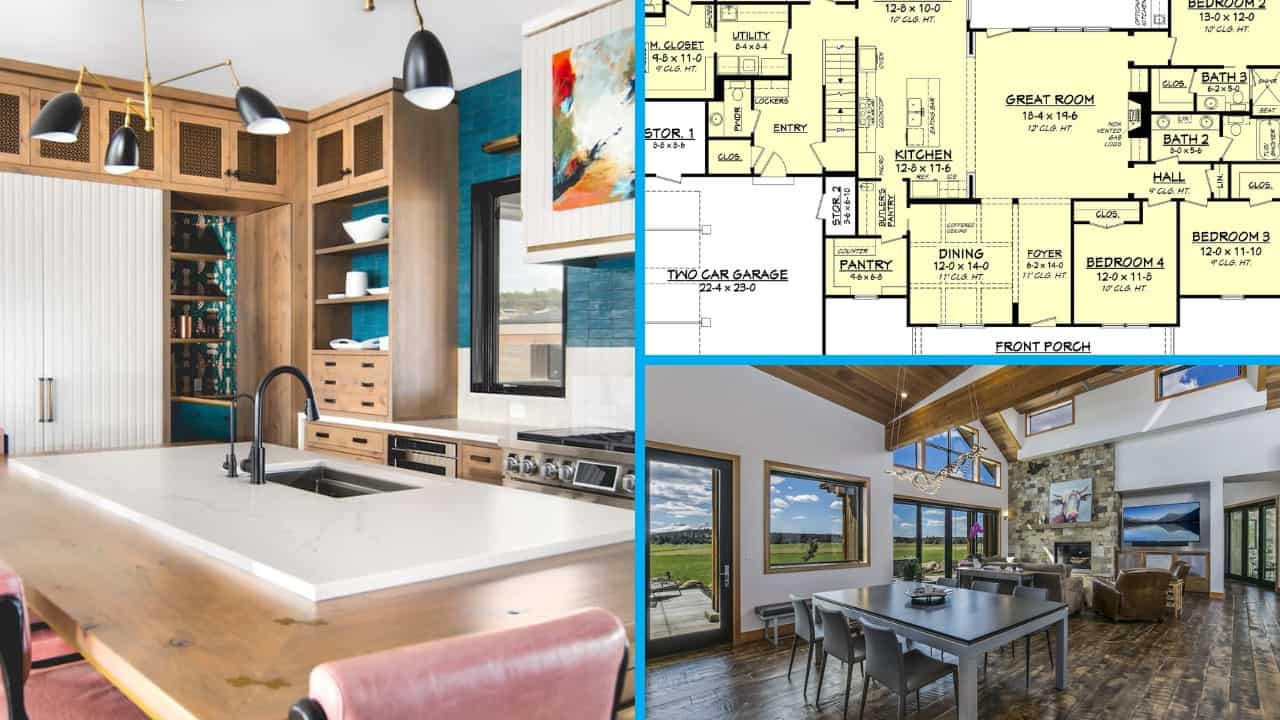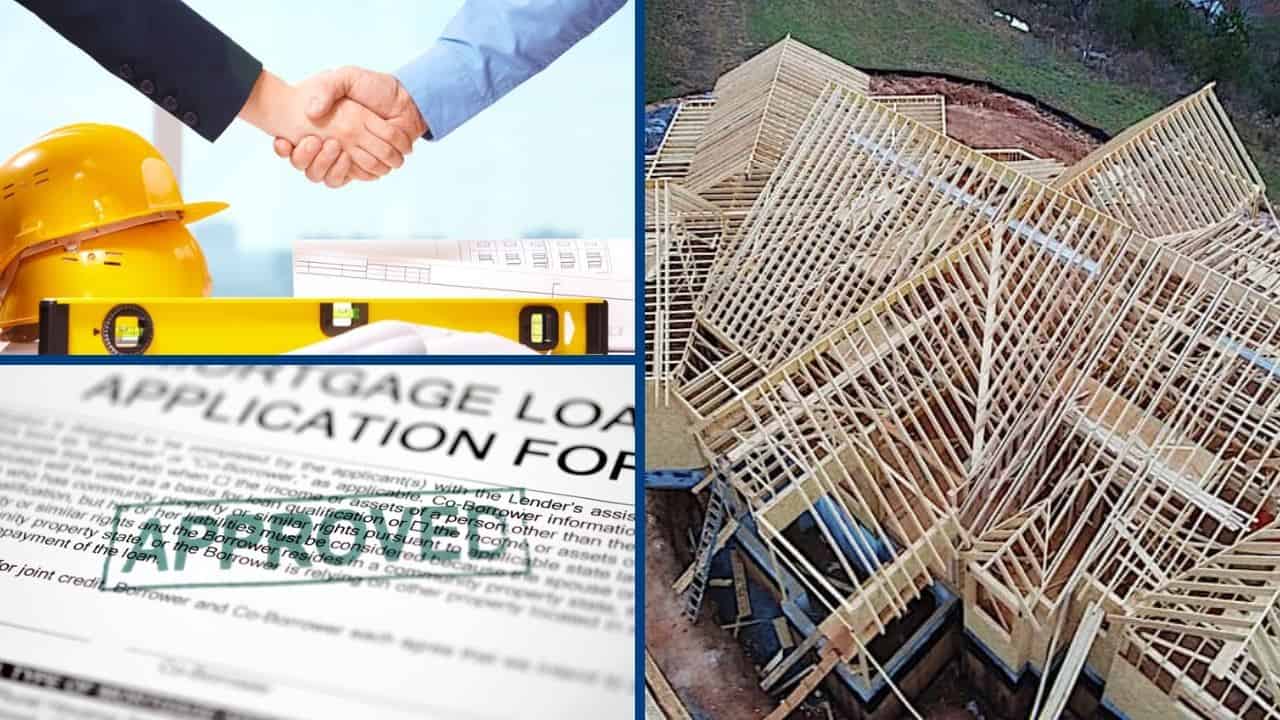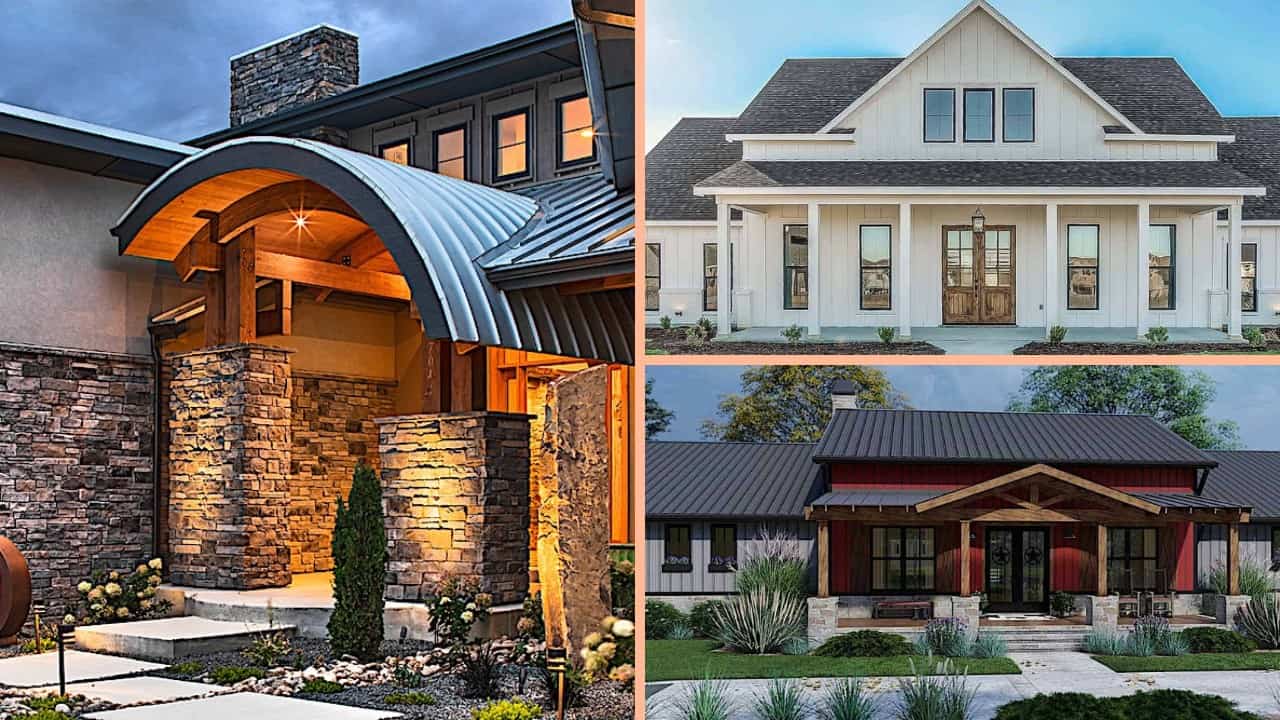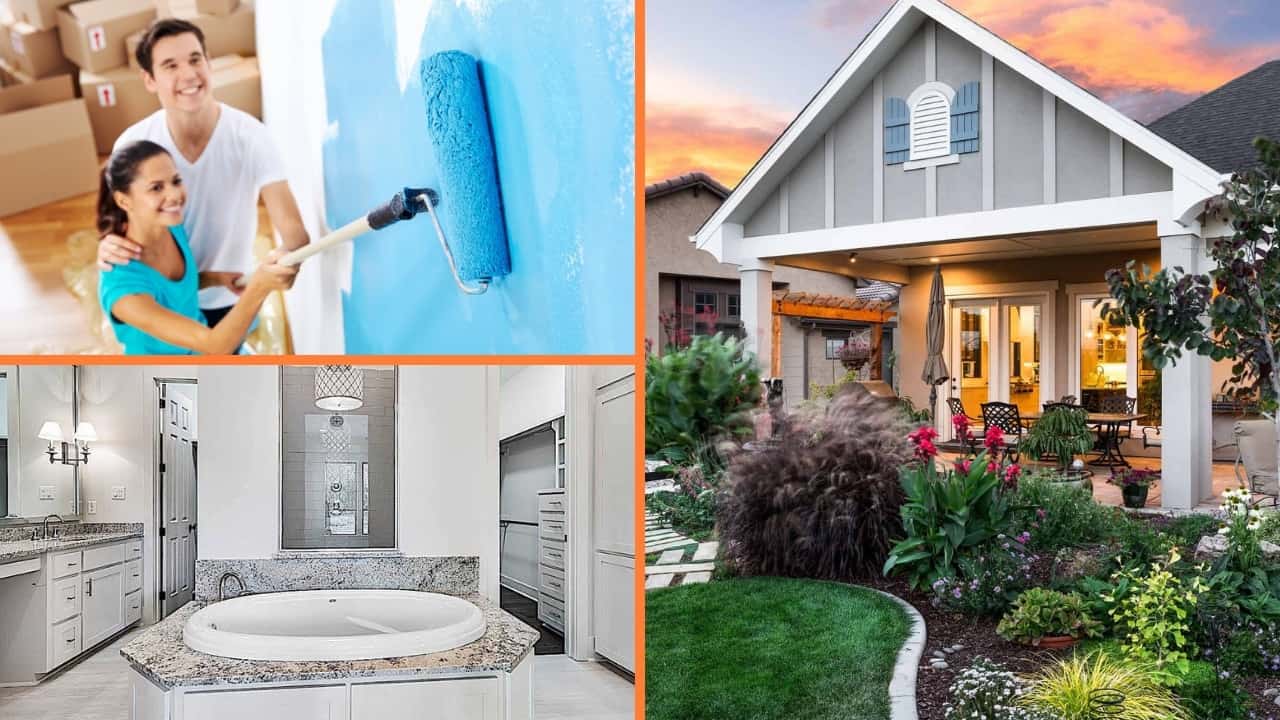Top Trends in House Plan Design for 2020
By Rexy Legaspi | Updated April 04, 2023
Planning to Build a New Home in 2020? Here’s What You Should Include
With features like zen dens, she sheds, dark exterior facades, and smart mirrors having made an impact in new housing and new home design in 2019, what’s ahead? Well, a number of exciting and imaginative trends are unfolding as we start a new year and a new decade.
So what can you expect in 2020? We have been pondering questions about open floor plans, family gathering areas, low-impact “green” houses, quality of lifestyle, the modern farmhouse, and environmental issues – and as it turns out, trend experts are ready to share their ideas.
The Plan Collection gathered data from architects, builders, realtors, contractors, and other experts in the housing industry for their predictions on design trends for 2020. Let’s explore some of the innovations that are anticipated to make their way into consumer homes within the next year.
What’s trending in 2020?
1. Sweet Suites
Consistently gaining in popularity in recent years, dual master suites are among the hottest amenities in new homes, according to Doug Schoonover of Schoonover Design Group. “Typically, we’ll include a full blown master suite on the main level of the home and then a more subdued, scaled-down version, usually on the same level but on the opposite side of the house – or sometimes upstairs,” Schoonover says. “We refer to these secondary areas as ‘princess suites.’”
What’s driving the popularity of dual suites? The most important – and obvious – reason is the flexibility they provide for a variety of living conditions. But there’s also the desire for comfort and luxury – and uniqueness: “Almost no re-sale homes offer this, and the concept appeals to many different buyers,” says Greg Dodge, Vice President of Design Basics, LLC.
As multigenerational households become more common – and, with an increasing number of Americans sharing their space with parents, grandparents or adult children, builders are adding these dual master suites to new homes. Simply said, the extra master suite can accommodate the needs of an elderly parent, in-laws, an adult child deciding to stay permanently with the parents, two friends buying a home jointly, and both Baby Boomers and Millennials. They are basically scaled-down versions of in-law suites and are attractive when the need for that extra space – sitting room, kitchenette, separate entrance, etc. – isn’t there.
The demand for dual suites also comes from baby boomers who want separate suites to accommodate different sleeping habits or to avoid the other person’s snoring. And young couples who have different work schedules – or who want their own space – are going for them.
2. Family Fun Time: The Lounge/Loft
Sure, there’s the Great Room/Family Room that is sometimes “invaded” by guests and friends. But today’s potential buyers who have children are also looking for a different space in the home – designated as a family lounge.
This is the spot – close to the bedrooms – where the family can hang out with each other, play games and puzzles, and just enjoy each other’s company. “Away from the noise and traffic in the kitchen and the living room, children can do their homework independently or with help from their parents. In the Family Lounge, the young ones can play/entertain friends and neighbors – separate from the Great Room/Living Room where adults generally gather,” says Dodge.
The family lounge could also incorporate a kind of activity center – a dedicated space in the home for pursuing favorite activities. Think of a game room with defined spaces to designate the different zones for scrapbooking, arts and crafts, sewing, hobbies, board and video games, activity/card tables, billiards/pool, foosball, and watching sports on TV.
Top: The second-story floor plan of a European style home with 2,708 sq. ft. of living space, 4 bedrooms, and 3.5 baths includes a family lounge that is located near the bedrooms (Plan #120-2481). Bottom: Check out this loft in a 2-story, 5-bedroom, 5.5 bath Country style home that serves as a Family Lounge. The space – on the second floor in close proximity to the kids‘ bedrooms – is outfitted with a comfortable sitting area, large-screen TV, and a chess board, and is a great gathering place where family members can unwind, read, or play games. The house has a separate conventional family room on the first floor (Plan #153-1121).
This family lounge/game room – in a magnificent two-story, 6,563-sq.-ft. European style home – features a ping-pong table, foosball, a bar, and seating area where family members can relax or play cards or board games. This room can be reconfigured to accommodate spaces for other family activities (Plan #161-1077).
3. Super-Island: The Kitchen Island Gets a Makeover
Design trends continue to feature the kitchen and its many accessories – and in 2020, the oversize kitchen island is in the spotlight – and on the must-have lists of home buyers.
Greg Dodge of Design Basics says that customers are asking for “five-foot-deep islands which have back-to-back 24-inch-deep base cabinets, plus a 12-inch eating bar on at least one side.” An oversize island allows seating on two sides to accommodate family and friends. It also provides more workspace in the kitchen as well as storage for cookbooks and small appliances.
To make the kitchen island more functional, you can add an extra sink, refrigerator, dishwasher, or even a wine cooler. And for added style and flair, use a pop of color to the cabinets and stool cushions.
Top: A huge kitchen island occupies the entire length of the kitchen in this luxurious 2-story European style home with 4 bedrooms, 4.5 baths. and other amenities spread across 8,503 sq. ft. of space. The perfectly sized island allows seating on both sides. Bottom: Another view of the oversize kitchen island shows a good number of cabinets and drawers for storage space, an extra sink, and a dishwasher. And check out the splash of color in the base cabinets at right (Plan #106-1295).
4. Work from a Pocket
While a growing number of people work from home, they don’t really need – or even want – a full-blown home office. With the availability of wireless technology, people can work from any corner of the home, even the porch or the sunroom.
So why waste all that space on a dedicated home office when you don’t really spend much time in it? Consider a pocket office for some of the work you do at home. And although typically smaller than a traditional home office, a pocket office still provides privacy for the work space and usually affords enough room for a desk, computer, printer, and office supplies. In addition, "Some people may not work in their pocket office, taking advantage of wireless technology and preferring the inspiration of their sunroom to develop the next presentation or edit their white paper, yet still want a modest space that houses the printer and office supplies," says Desgin Basics Dodge.
Don’t go big if all you need is a smallish space that allows you to accomplish your work efficiently and in a timely manner.
Top: This floor plan of a modest 1-story, 3-bedroom, 2-bath Country style home makes efficient use of every square foot, including the pocket office off the Great Room (Plan #120-2525). Bottom: It may be a small corner of the home … but this pocket office on the main floor of a spectacular 1.5-story home with 3 bedrooms, 2 baths and 2,854 sq. ft. of living space more than serves the purpose of working at home. There’s a comfortable lounge chair, an ergonomic office chair, a desk, computer, shelves, and cabinets for office supplies – and more importantly, a door to afford privacy and quiet (Plan #142-1209).
5. Industrial Chic / Recycled Materials
What started, naturally enough, as a style seen in converted lofts and other commercial areas converted to living spaces, industrial chic has moved to single-family urban, suburban, and rural homes. The style combines utilitarian design and worn, vintage materials like reclaimed wood and recycled materials and is characterized by the combination of raw materials like iron, wood (especially repurposed lumber), aluminum, galvanized or stainless steel, glass (both new and vintage or recycled), and recycled plastic for building materials.
Common elements include exposed brick or stone walls, concrete floors, exposed beams, unfinished or natural-looking wood and other materials, and stainless-steel accents. The no-frills look is common especially in architectural styles like Mid-century Modern and Contemporary Farmhouse (trend see #9).
6. Can a Garage Be Too Big? Apparently, Not Yet
Among the most requested new home design items are oversize or three-car garages – with more space surrounding the cars. In fact, more than 20 percent of single-family homes built each year since 2013 have included three-car garages.
And according to Housingzone.com/Professional Builder Magazine, "the newest symbol of status in home ownership is the size of the garage to fit the familys SUVs.” With the shift to bigger/taller SUVs and pickups, todays garages are being built or remodeled to make space for the larger vehicles and provide enough room for storage.
To fit the taller vehicles, the 7-foot-height overhead-door clearance has been changed to 8 feet – and some builders even go as high as 12 feet to accommodate loaded roof racks.
As vehicles become the version of adult toys, homeowners are making their garages wider, taller, and longer, and adding rooms to the back.
Top: If you’re a car enthusiast, this garage in a magnificent 2-story European style home is made just for you. The oversize garage can fit 3 cars with enough space between each car – plus a room for a shop. By the way, the home has 5 bedrooms, 6.5 baths, a Great Room with a 2-story ceiling, an outdoor living space with an outdoor kitchen, a wet bar located off the Great Room, and other amenities. Bottom: This view of the garage shows the ample space between the cars that allows smooth movement to, from, and around them. The tall ceiling can accommodate any overhead racks (Plan #193-1125).
7. Wide Open Spaces: Outdoor Living Blurs with the Indoors
Remember when outdoor living entailed a deck or patio with table and chairs, maybe space for patio chairs with cushions, and a grill? Well, say goodbye to that idea and embrace more expansive outdoor living areas. "Outdoor spaces are still very strong, and we are actually getting requests to make them even larger," says Jonathan Boone of House Plan Zone.
Today, outdoor spaces are bigger, more stylish, sophisticated, and equipped with the latest in technology. We’re talking rear porches and patios with LCD and LED flat-screen televisions, entire kitchens with sinks, dining areas, fire pits, and fireplaces.
Balconies, terraces, and patios are being redesigned to extend the Great Room to the backyard – and seamlessly connect the indoors to the outdoors. “Glass walls” that allow spaces to open completely during warm weather are predicted to pick up in popularity. These are multiple sliding glass panels that can be fully retracted to one or both sides of the space to open it up to the outdoors. When closed, the glass panels protect the area from rain, dust, noise, insects, and strong winds.
Top: This attractively furnished, bright, sunny and spacious Great Room in a 1-story, 3-bedroom Contemporary style home comes with a vaulted and sliding glass panels that open to the outdoor space. Bottom: Open the retractable glass panels, and enjoy nature and outdoor living. There are lounge chairs, an outdoor dining area, a hot tub (not shown), and a grill (Plan #202-1013).
Top: Here’s an amazing 2-story, 4,501-sq.-ft. Country home with spectacular outdoor living area. In addition to the dining area and the outdoor kitchen, there’s a fireplace to keep everyone warm and comfortable on chilly nights. French doors allow views of the beautiful landscape and natural surroundings – and open up to the outdoor space. The home includes 5 bedrooms, 5.5 baths, a balcony, home office, family room, guest room, and other features. Bottom: Sit and relax in this area of the outdoor space and enjoy the warmth of the fireplace (Plan #153-1121).
8. Going Green Gets Serious: The Zero Energy Home
In 2020 and beyond, concern for a healthy living environment and a dedication to its care will be more the norm than a trend. With engineers and designers rethinking the way they build in the face of climate change, the attention will be on eco-friendly materials and designs, energy efficiency, using fewer resources and tighter, higher-insulated buildings.
We will see more buildings and homes in tune with nature and yet open to smart technology for greater energy efficiency. New advancements in technology are allowing more people to build and live in “zero energy” homes – which combines more thoughtful home design and superior building systems with energy efficiency and alternative energy sources, such as solar panels.
Leading the pack is California, which will start requiring all new builds – single-family homes and multi-family residences – to include solar panels. With this move California is expected to add 100,000 a year of zero net energy homes to the current U.S. total of about 5,000 zero net energy single-family homes.
There’s no looking back. Zero net energy homes are here to stay!

Even a conventional home that is built using advanced framing techniques, sealed and insulated to the highest standards, designed with a state of the art air-exchange system, and uses solar-supplemented electricity and be energy net zero or near energy net zero (photo credit: Solar Panels on House by Gary Watson under license CC BY-SA 3.0).
9. Yes, the Contemporary Farmhouse Is Still on the Trending List
The answer to the question “Is the Farmhouse style still happening?” is a resounding yes! Designers agree that the Farmhouse style’s popularity is increasing, especially in its modern, transitional form: light – often white – vertical siding, metal roof or roof accents, shed dormers and bump-outs, clean lines with no frills, and a main-floor master suite rather than the more traditional second-floor master. According to House Plan Zones Boone, the Contemporary Farmhouse is his company’s top-selling plan style.
It’s easy to see why Americans are captivated and charmed by the Farmhouse style. There are the simple, clean lines, the traditional welcoming porch – sometimes a wraparound – dormers, gable roof, and large, spacious kitchens. And above all, the farmhouse is adaptable – with each design differing from one home to another. It can be quaint and folksy, stylishly modern, or chic and sophisticated. You can’t go wrong with the farmhouse!
Want curb appeal and charm? How about this eye-catching 1-story, 3-bedroom, 2-bath Contemporary Farmhouse with touches of the Craftsman and Arts and Crafts styles. Take a look at the attractive features that will stop you on your tracks: brick siding that add a splash of color to the exterior facade; the covered porch supported by matching columns that frame the large-paned glass windows, and the wood and glass double door (Plan #142-1184).
10. First There Was Xeriscaping — and Now, Firescaping
This is one trend we would prefer not to add to our 2020 trending list. Over the past decade, many regions of the country have been managing through periodic or long-term droughts. To adjust to this environment, many homeowners have chosen xeriscaping – a no-water or low-water landscape design – as a practical and often low-maintenance outdoor design alternative.
However, with wildfires becoming far more prevalent in some parts of the country, expect to see a growing trend among homeowners toward "firescaping" – creating a landscape around the home that is resistant to fire.
- firescaping, the landscape immediately around the home (out to about 30 feet) includes concrete, stone, or brick patios and walkways. The vegetation close to the home is typically ground cover, low annuals, or low perennials. Any trees near the house are usually relatively short and deciduous given their higher moisture content. Branches are cut to be clear of the roof of the home. In short, the closer the landscape is to the home, the more resistant it is to fire. Between 70 and 100 feet out from the house is the area for gardens, fruit trees, and other plantings. Lower limbs should be no less than 15 feet off the ground. One hundred feet or more from the house is the zone for trees. They should be pruned so that crowns are at least 10 feet from each other, and lower limbs should be no closer than 10 to the ground.
The good news is that horticulturalists and landscapers familiar with firescaping can create an attractive, natural, and functional outdoor living space. The number and type of green and flowering plants available allows for a varied landscape. Building products with a “natural” appearance yet fire resistant are now readily on the market.
Other trends that we may see continue in 2020 include:
-
The Laundry Room is the designated location for design fun as homeowners experiment with floral wallpaper; bold, cheerful hues; and patterns.
-
Bathrooms will continue to be developed as spaces for relaxation and recovery. We all know about their spa-like features – whirlpools, saunas, showers with a hydro massage cabin. Home decor experts predict that in 2020, benches, stools, and window seats will be common, particularly in master baths.
This amazing master bath in a 2-story, 4,501-sq.-ft. Country home includes a whirlpool tub, walk-in shower, water closet and two large, walk-in closets. And there’s a chaise lounge for unwinding before getting into the fabulous tub (Plan #153-1121)!
As the 2020s unfold, we can expect designs that emphasize wellness, sustainability, and energy efficiency – as well as bold, fun, and quirky elements. So get ready for the ride!
Footnote: The lower left photograph in the lead image of this article is a Family Lounge area in a spectacular 1-story, 4-bedroom, Country style home with 2,686 sq. ft. of living space. The space is actually in the bonus room over the garage that was finished as the lounge (Plan #142-1169).
Additional Sources:
About Us
Find Your Plan
Find Your Plan
Our Services

Offer code valid for 60 days
Sign up and save $50
on your first order
Sign up below for news, tips and offers. We will never share your email address.
Products under $300 excluded.
Thank you for signing up!
To receive your discount, enter the code "NOW50" in the offer code box on the checkout page.























